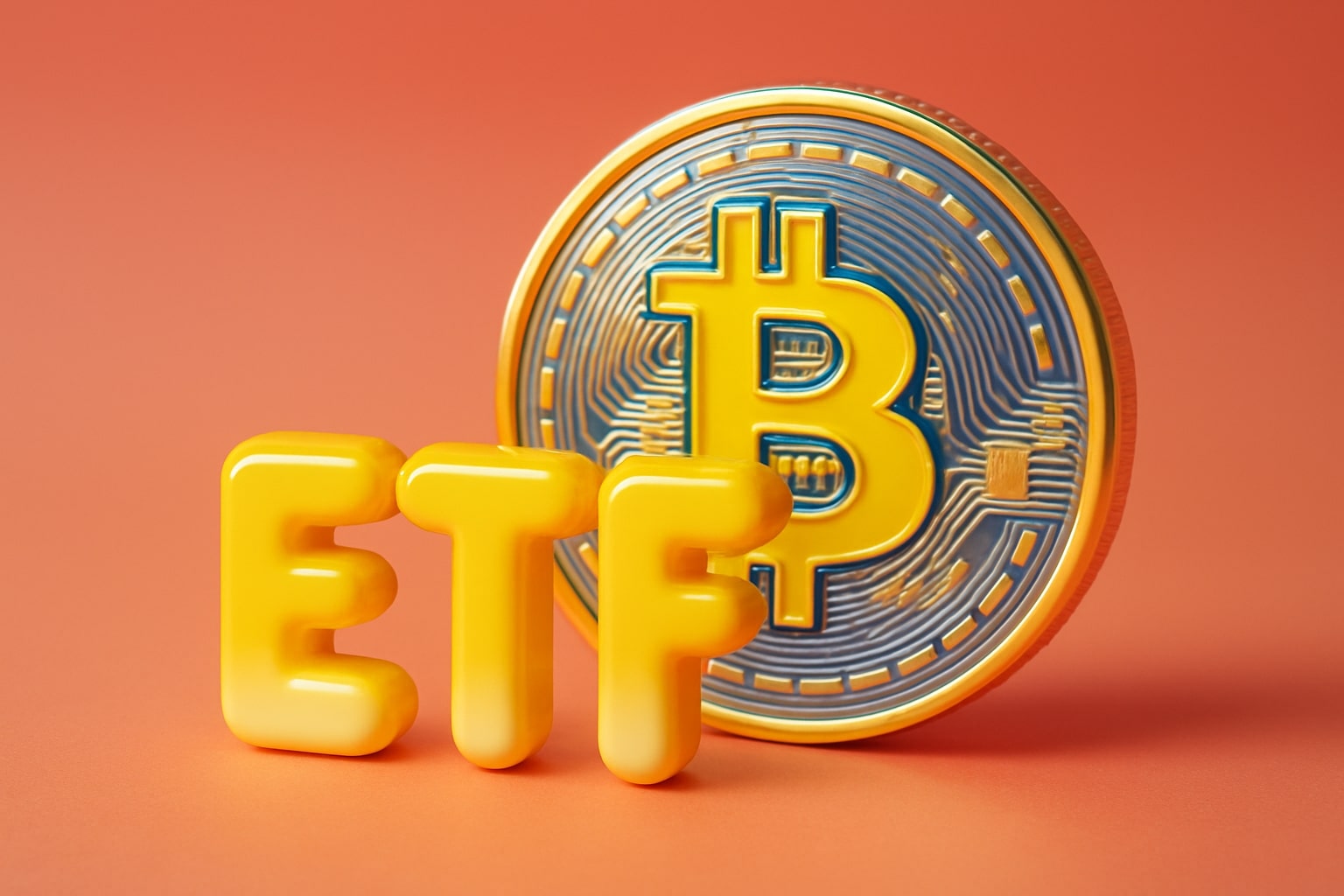
Bitcoin ETF Inflows Soar to $931M as BlackRock’s IBIT Leads $324M Uptick, BTC Stabilizes at $107,547
BTC-USD steadies near $107,547 after record ETF inflows push total AUM above $149B; BlackRock’s IBIT drives institutional demand, Fidelity’s FBTC and Grayscale’s GBTC follow as 1.5M BTC locked under management | That's TradingNEWS
Bitcoin ETF (BTC-USD) Inflows Surge to $931 Million as Rate Cuts and Market Volatility Redefine Institutional Exposure
Bitcoin (BTC-USD) continues to dominate institutional flows, with $931 million in new ETF inflows recorded during the latest week—marking one of the strongest accumulation phases since the Federal Reserve began its rate-cutting cycle. The surge came after a volatile period in which $470 million exited spot Bitcoin ETFs in a single session following the 25 bps Fed rate cut to the 3.75–4.00% range, before buyers aggressively returned as inflation data and macro sentiment improved. The total year-to-date inflows into Bitcoin ETFs now stand at $30.2 billion, lifting combined assets under management (AUM) to approximately $149 billion, representing about 6.7% of Bitcoin’s total market capitalization.
Institutional Rotation: From Outflows to $931 Million Weekly Inflows
Data from multiple asset monitors show a swift reversal from the prior week’s $513 million in outflows to nearly $921 million in net inflows across crypto investment products, of which Bitcoin accounted for the overwhelming share. The shift coincided with softer-than-expected inflation prints—CPI up 0.3% MoM, 3% YoY—that restored confidence in additional Fed easing before year-end. Institutional trading volumes across digital asset ETFs surged to $39 billion for the week, well above the 2025 average of $28 billion, signaling renewed institutional participation. The U.S. market led with $843 million in inflows, while Germany-based funds attracted $502 million, marking one of their largest weekly inflows ever recorded.
Fed Policy, Rate Sensitivity, and ETF Liquidity Patterns
The Federal Reserve’s second consecutive rate cut triggered a brief liquidity shock across all asset classes as Chair Jerome Powell’s hawkish tone tempered optimism for further easing in December. Bitcoin (BTC-USD) dropped momentarily to $109,000, before stabilizing above $110,000 as ETF flows absorbed panic selling. The sharp $470 million ETF outflow on October 29 reflected algorithmic de-risking rather than long-term redemptions. Fidelity’s FBTC led withdrawals with $164 million, ARK Invest’s ARKB followed with $143 million, and BlackRock’s IBIT reported $88 million in outflows. Grayscale’s GBTC shed $65 million, while Bitwise’s BITB saw only $6 million withdrawn, confirming that institutional portfolios continue to rotate rather than liquidate exposure.
BlackRock’s IBIT and Fidelity’s FBTC Maintain Dominance in Holdings
Despite temporary volatility, BlackRock’s iShares Bitcoin Trust (IBIT) remains the leading fund globally, holding over 805,000 BTC, valued near $87 billion at current spot prices. Fidelity’s FBTC retains second position with approximately 295,000 BTC, and Grayscale’s GBTC, now converted to a spot ETF, manages roughly 270,000 BTC after months of redemptions. Collectively, U.S.-listed Bitcoin ETFs now control more than 1.5 million BTC, equivalent to about 7.1% of total circulating supply. Analysts emphasize that such concentration is tightening available supply in the open market, reinforcing Bitcoin’s long-term scarcity narrative.
Cross-Asset Divergence: Ethereum and Altcoin ETFs Show Weakness
While Bitcoin ETFs benefited from the macro tailwinds, Ethereum (ETH-USD) investment products posted $169 million in weekly outflows, marking the first decline in over a month. U.S.-based Ethereum spot ETFs alone recorded $243.9 million in outflows, partially offset by inflows in Europe and Asia. Total Ethereum ETF AUM fell to $26 billion, with cumulative inflows since inception near $14.6 billion. Meanwhile, Solana (SOL-USD) and XRP-linked ETPs added $29.4 million and $84.3 million respectively—down over 80% from the previous week—as investors consolidated positions into Bitcoin exposure following the rate announcement.
Macro Drivers Reinforce Bitcoin’s Role as Institutional Inflation Hedge
The narrative behind the inflows is anchored in expectations that the Fed’s rate trajectory will weaken the dollar while supporting hard assets. The U.S. Dollar Index (DXY) slipped to 99.34, and U.S. 10-year Treasury yields fell to 4.11%, creating conditions favoring alternative stores of value. Bitcoin (BTC-USD) remains the prime beneficiary, increasingly viewed as a high-beta inflation hedge with liquidity comparable to gold-backed ETFs. Institutional survey data indicate that more than 42% of hedge funds with digital exposure plan to raise their Bitcoin allocation in Q4 2025.
Regional ETF Dynamics: Divergence Across U.S., Europe, and Asia
Regional trends show strong contrasts. The U.S. ETF market led with nearly $446.3 million in inflows on the week, dominated by BlackRock’s IBIT and Fidelity’s FBTC. Germany’s ETPs brought in $502 million, while Switzerland saw $329 million in outflows, largely explained by asset rebalancing between providers. In Asia, Hong Kong’s newly listed Bitcoin ETFs recorded modest $68 million in cumulative inflows, reflecting early-stage institutional engagement post-regulatory approval.
Read More
-
SCHD ETF Price at $27: Can SCHD’s 4% Yield and 9.15% Dividend Growth Beat High-Yield Covered Call ETFs?
15.12.2025 · TradingNEWS ArchiveStocks
-
XRP ETFs Close on $1B Inflows as XRPI at $10.92 and XRPR at $15.52 Hit 52-Week Lows
15.12.2025 · TradingNEWS ArchiveCrypto
-
Natural Gas Price Forecast: NG=F Holds the $4 Floor as Oversupply Clashes with 2026 LNG Demand
15.12.2025 · TradingNEWS ArchiveCommodities
-
USD/JPY Price Forecast - Dollar to Yen At 155: Yen Strength Builds As BoJ Hike And NFP Collide
15.12.2025 · TradingNEWS ArchiveForex
Market Reaction and Price Correlation to ETF Flow Volatility
BTC-USD traded around $107,547 at press time, down 3.74% daily, mirroring short-term profit-taking across all ETFs after heavy inflow-driven rallies earlier in October. Bitcoin’s market cap remains near $2.1 trillion, and the correlation between ETF inflows and price continues to intensify. Each $1 billion of net inflow historically corresponds to an average 2.2% upward move in Bitcoin’s spot price, according to aggregated exchange data. The total AUM of Bitcoin ETFs at $149 billion now represents over one-fifth of the $700 billion managed across all global digital asset products.
On-Chain Metrics Show Stable Accumulation Despite Volatility
On-chain data reinforce the institutional narrative. Exchange balances have dropped by 38,000 BTC in the past month, signaling strong cold-storage accumulation. Long-term holder supply (coins held >1 year) has reached an all-time high of 14.98 million BTC, underscoring investor conviction despite macro noise. Meanwhile, miner flows into exchanges declined 12% week-over-week, suggesting limited selling pressure even as prices retest $107,000–$110,000.
Strategic Rotation and Market Sentiment
Market behavior shows that ETF investors are increasingly using rate-driven dips to scale positions. Weekly inflows of $931 million indicate that macro-sensitive traders shifted from tech equities into digital assets as yield expectations softened. Analysts note that even after last week’s turbulence, aggregate 2025 inflows of $48.9 billion across all crypto ETFs point to institutional normalization of Bitcoin exposure as a mainstream allocation. The ratio of ETF to exchange trading volume hit 18%, its highest level since launch, emphasizing that the spot ETF structure now defines liquidity cycles in crypto markets.
Outlook: ETF Demand Anchors Bitcoin’s Structural Bull Market
Bitcoin ETFs have reshaped institutional exposure with an unprecedented absorption of circulating supply, deep liquidity, and growing cross-border adoption. As BTC-USD consolidates near $107,000–$110,000, sustained inflows and macro rate easing remain key drivers of upside momentum. With AUM surpassing $149 billion, weekly inflows above $900 million, and institutional concentration above 1.5 million BTC, the long-term trajectory remains structurally bullish. Bitcoin’s role has shifted from speculative risk to a recognized asset class within global portfolios — a transformation now quantified in ETF balance sheets rather than ideology.

















